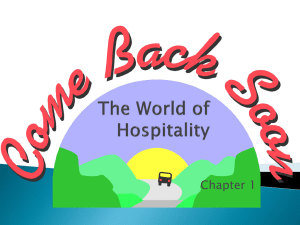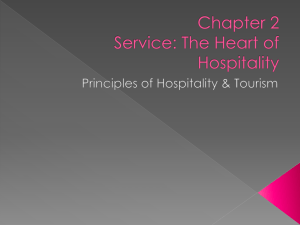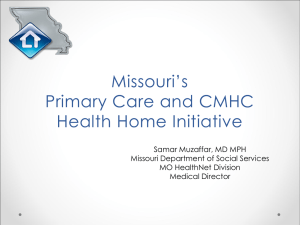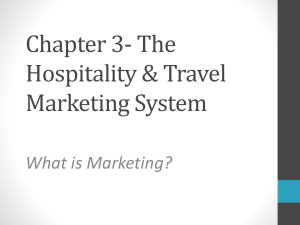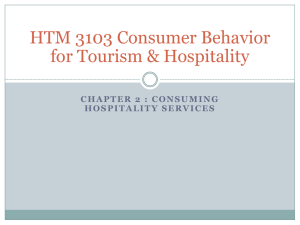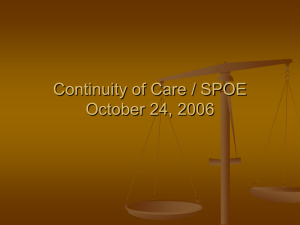Recovery oriented Acute and Crisis Services in Trieste
advertisement
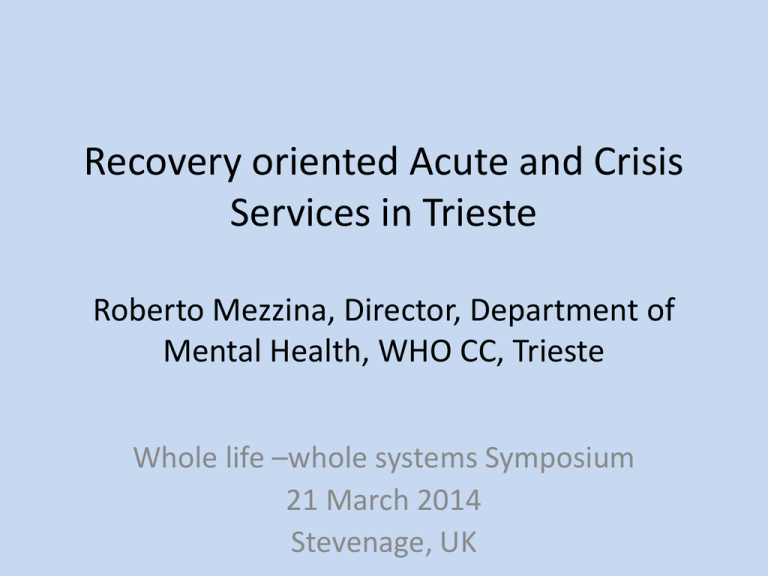
Recovery oriented Acute and Crisis Services in Trieste Roberto Mezzina, Director, Department of Mental Health, WHO CC, Trieste Whole life –whole systems Symposium 21 March 2014 Stevenage, UK Crisis services as alternatives to hospital? • An individual in crisis generally enters a psychiatric network in which psychiatric hospitalisation is the last resort. • Crisis interventions and home treatments are often (always) partial alternatives to inpatient care: even when tremendously effective, they select their cases according to treatable conditions tailored on their operational limitations (e.g. safe respite places) and risk evaluations. • Their are time-limited and don’t provide an ongoing project of care. Alternatives to something else? • Our hypothesis is that community services must be conceived as alternatives not to a place, but to a conception of treating illness that is based on a reductionist psychiatry, which contain and impoverish the individual's experience as a patient. Therefore: • Are services tailored on illness management or social behavioral problems, or around the person and his/her experience? • Thus the need for a strategic (effective) but mostly humane and comprehensive viewpoint • • • • • • Overarching criteria / principles of community practice in the MH Dept. Responsibility (accountability) for the mental health of the community = single point of entry and reference, public health perspective Active presence and mobility towards the demand = low threshold accessibility, proactive and assertive care Therapeutic continuity = no transitions in care Responding to crisis in the community = no acute inpatient care in hospital beds Comprehensiveness = social and clinical care, integrated resources Team work = multidisciplinarity and creativity in a whole team approach – the same team with several functions such as crisis intervention, ACT etc Whole life approach = recovery and citizenship, person at the centre Responding to crisis in the community • Intervention is as far as possible in vivo, within service users’ homes or other places they frequent. • Responses are quick and flexible, avoiding waiting lists and other bureaucratic obstacles to accessing services. CRISIS AT THE HEART OF MH CARE Make full “use” of the crisis: • Crisis is multiplying resources • Crisis is increasing informations and knowledge around the person • Crisis is increasing communication within the service (“subjectivization”, “illumination” as a social visibility) Continuity of care • This is a guiding principle and involves treating service users within the usual care system and maintaining them in their usual social context, thus avoiding de-socialisation and institutionalisation. • Follow-up is provided wherever service users are. • Interventions take place: in the patient’s actual living environments; within social-health institutions; in legal-penal institutions (Courts of law, prison, forensic hospitals) • Temporal continuity: this is defined based on the need for care and the threefold criteria of prevention/care and rehabilitation. Integrated and comprehensive response (social and medical) • Therapeutic plans are based on individual history, needs and wishes. It allows the service to obtain and maintain service users’ consent to and engagement in treatment. • Establishing a relationship is the first priority. • Comprehensive/integrated responses between social and health, therapeutic and welfare assistance. This involves: • the use of resources which the Service has available; • the activation of health and social services; • the use/exploitation of resources which may be present in the micro-social context. Resources directly provided by the Centre concerning whole life and recovery: • living situation (restoration, maintenance and cleaning, the search for other housing solutions) • money, income (cash subsidies, use of the safe in centre, daily money management on a temporary basis, action taken in defense and protection of property) • personal hygiene (laundry, personal cleanliness, hairdresser, linens) • work possibilities (assignment to a co-operative society, chores at the centre, work grants) • free time (workshop in theatre, painting, music, graphics, sewing, ceramics, gymnastic and boating, day trips, holidays, parties, cinema, shows). Whole team approach • Fully multidisciplinary working is a central goal, including integration of social care and partnerships in care with other community services and nonprofessional and volunteer inputs. • The aim is to formulate collective understandings of service users’ situations and shared therapeutic plans. • Frequent on-site multidisciplinary training and other joint activities underpin this comprehensive team working. A value based service The services are value-driven, in that their focus is on: • Helping the person, not treating an illness. • Respecting the service user as a citizen with rights • Maintaining social roles and networks. • Fostering recovery and social inclusion • Addressing practical needs that matter to service users • Change the attitude in the community Access and response in a crisis • 8-20: Direct referrals to the CMHC, non formality, real time response (mobile front line) - as a roster • 20-8: access to the consultation at th emergency Unit (6 beds) through casualty dept, then overnight accomodation in the emergency unit. But: • No admissions in the emergency unit as a rule. Thus: • The day after the CMHC team comes. The 24 hrs rule: within 24 hrs otherwise admitted. Usually: • Crisis supported at home or hosted in the Centre • Avoiding invol. treatments • Invol. Treatments in the CMHC as a first choice Key procedures • Emergency reduced to a minimum (proactivity and continuity of care de-construct emergencies) • Walk-in, immediate intake and assesment, easy access, low threshold to early signs, respite to deescalate, etc • Early and quick intervention in real time: take your role and be responsible. This reassures agents of referral, e.g. relatives and the SN in general. The Centre as a resort for crisis respite • Hospitality is agreed without formalities with user and relatives, and decided and managed by the same team (e.g. in case of a not agreed self-discharge, the team operates a renegotiation; the plan of care is decided or re-discussed during the admission / hospitality) – team sense of ownership • users/guests can receive visits without restrictions and are encouraged to keep their ordinary life activities and the links with their environment (operators and volunteers do activities outside with them everyday) • it is done in the same place where users come for everyday care and rehab, therefore crisis is “soluted” and unemphasised in everyday life • often it is followed by a period of day hospital attendance to strengthen and develop the therapeutic relationship and the ongoing plan of care. Mean duration of 24 hr admissions is 1012 days. Crisis management in the Centre Actions in crisis management • Personalise the ‘control’ of the problematic or difficult user, including personalised side-by-side assistance if necessary • Contracting the form of acceptance/admission with the user, from the DH to daynight hospitality (Status of ‘hospitality for health)’ • Continuous effort to obtain compliance with treatment/care through a relationship based on trust • Inclusion of the user in crisis in both structured and non-structured activities • Escape” / looking for / re-negotiating return: “what was wrong with you in the centre?” Involving the team • Information managed collectively (not by select individuals/operators) • Case notes and the team’s activities: should always be related to individual lifestories, group discussion and the group’s sense of community Mobilising human and institutional resources • A first network of relationships is provided by the operators whose willingness and availability is in direct relation to the closeness of their relationship with the patient. • Out of this informal way of containing his anxiety there emerges, at minimum, a personalized therapeutic relationship (key workers) with a limited nucleus of operators who make themselves more directly available in the various stages of the intervention, and thus “enter into play” with him. • Decoding crisis through the confrontation and mediation among different viewpoints and needs (PARTICIPATORY DECODIFICATION OF THE CRISIS) when the social system is involved. Maintaining the social system • Shared responsibility (among user, service, family and other users who will provide support) and constant search for agreement. • The inside and the outside of the therapeutic context (the user can go outside, though perhaps accompanied, may go back home for a period of time, request the response to immediate needs, etc.). • The CMHC's 24-hour hospitality does not sever ties with his/her environment (family contacts, time away from the centre alone or accompanied, taking care of specific personal needs). A social system intervention The only way to make social systems work is sharing responsibility and empowering them • De-codifying crisis through knowledge and narratives: participatory meaning-making aorund the question: “why the crisis?” • Individual plans (recovery phase) using all support systems, incl. the Centre as such. • Participatory de-codifying: understanding reasons and meanings / explanations • Mediating points of view: overlapping consensus • Relieving the burden: helping the others The 24hr CMHC is not: • A ward, which maintains the rituals of the hospital and where the community cannot enter • A residential facility, with different hours and rhythms that are modulated in accordance with everyday life • The availability of beds within a community service, or in facilities connected to it (respite) • A simple extension of service hours • The addition of a night-time on-call service in the community Advantages of the 24hr CMHC Point of reference open 24 hrs The personnel can be utilised flexibly Users can receive a wide range of responses The crisis comes into immediate contact with a system of resources/options, including for rehabilitation The user is always assisted by a single team that has a contractual relationship with him/her Advantages of the 24hr CMHC Both admission (hospitality) and release can be decided and agreed to immediately, without bureaucracy or referrals Avoids the immediate loss of contact with normal living contexts and networks Avoids the immediate loss of ability, and the role connected to one’s abilities, leaving the user active and free Reduces the stigma of hospitalisation Some relevant outcomes • In 2010, only 16 persons under involuntary treatments (7 / 100.000 inhabitants), the lowest in Italy(national ratio: 25 / 100.000); 2 / 3 are done within the 24 hrs. CMHC • Open doors, no restraint, no ECT in every place including hospital Unit • No psychiatric users are homeless • Every year 220 trainees in Social Coops and open employment, of which 10% became employees • Social cooperatives employ 600 disadvantaged persons, of which 30% suffered from a psychosis • The suicide prevention programme lowered suicide ratio 40% in the last 15 years (average measures) • No one in Forensic Hospitals 22 Outcomes in Trieste (crisis) • No involuntary treatments in Barcola • Reduction of nights in acute service in the general hospital • Even reduction of bed use in the Centre (to ¼) in 20 years including long term bed use. • Reduction of people arriving at the emergency call (118) and casualty dept. (50% in 20 years) – because of work carried out by CMHC • Acute presentations not so frequent anymore – less disorganised • Long-term care only in the community (at home, in the centres and group-homes), not in hospital – but it decresed. • Available alternatives e.g. woman recovery home Crisis research in Italy (Mezzina et al., 2005): the conclusions Determinants of a quick crisis resolution are: • use of a wide range of community interventions (networking, home treatment, family support, social work, rehab, job placement, etc), and an established trustee relationship while hospitalization does not have relations with any better crisis outcome. Hospitalization: • does not depend on “severity” (measured with a wide number of variables) • is more likely after the intervention of general emergency agencies (ambulances / police) • shows to a daily medium dosage of medications (BDZ / Antipsichotics) that is double From hospitalisation to hospitality • Institutional rules • Institutionalised Time • Institutionalised (ritualised) relations: among workers / and with users Time of crisis disconnected from ordinary life Stay inside A stronger patients' role Minimum network’s inputs • Agreed / flexible rules • Mediated time according to user’s needs • Relations tend to break rituals • Continuity of care before/during/after the crisis • Inside only for shelter /respite • Maximum co-presence of SN From hospitalisation to hospitality Difficult to avoid: Locked doors • Isolation rooms • Restraint • Violence Illness /symptoms /bodybrain • Open Door System • Crisis / life events / experience / problems So what helps people in crisis? • Trustee relationships • Continuity of care and of experience (no disruption) • Hope • Self-determination • The person’s history or narrative These are know as main factors for recovery Crisis and Recovery • The person in crisis must be enabled to pass through the crisis with his historical and existential continuity intact THUS: • The person's ties with his/her environment must be maintained • the links between the crisis and his/her life history must be identified • significant existing relationships must be reconstructed and redefined while new ones are formed. The crisis can loose its characteristics of rupture and dissolution of the existential continuity, and lead toward early and late recovery. The person and not the illness at the center of the process of care for recovery and emancipation through users’ active participation in the services (up close, nobody is normal) 30 Roberto Mezzina, Director WHO CC for Research and Training, MH Dept. Trieste roberto.mezzina@ass1.sanita.fvg.it www.triestesalutementale



